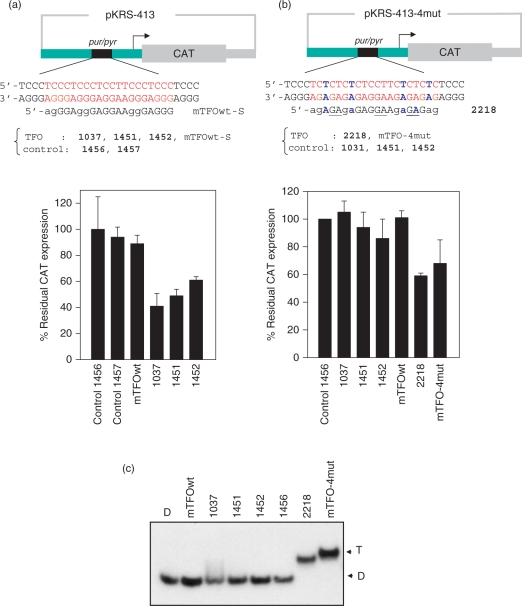Figure 9.
(a) CAT assay to determine the effect of the designed twisted-intercalating TFOs on the activity of KRAS promoter. Plasmids pKRS-413 (2 μg), containing CAT driven by the mouse KRAS promoter, and pTK-βgal (50 ng) were co-transfected with murine TFOs 1037,1451,1452, mTFOwt or control 1456 and 1457 (1 μM), using jet-PEI. The expression of CAT, with respect to that of β-gal, was determined by an ELISA assay, 48 h after transfection. The percentage of residual CAT expression, [(CAT/β-gal)TFO/(CAT/β-gal)Control] × 100, is reported in the histograms. The values are the average of three independent experiments in duplicate. Error bar are ± SE; (b) transfection experiment as in (a) but with the mutated plasmid pKRS-413-4mut in which the KRAS promoter has been mutated at the pur/pyr target introducing 4 G-to-A mutations. The mutated target is recognized by the TINA conjugate 2218 (5′-agAGPAgaGAG-GPAAgaGPAGag; P indicates a TINA modification; the lower case letters indicate the bases linked by a phosphorothioate group) and mTFO-4mut (5′-AGGGAGAGAGAGAGGAAGAGAGAGAGGG); (c) EMSA showing that triplex formation occur between the mutated pur/pyr target and TINA–TFO 2218 and mTFO-4mut, but not with the TFOs designed for the wild-type pur/pyr sequence (mTFOwt, 1037, 1451, 1452). TFOs and target were incubated overnight at 37°C in 50 mM Tris–HCl, pH 7.4, 50 mM KCl, 10 mM MgCl2, 2 mM spermidine and run in a native 20% polyacrylamide gel. The mutated duplex was formed mixing 1:1 5′-GCTCCCTCTCTCTCTCCTTCTCTCTCTCCCG and 5′-CGGGAGAGAGAGAAGGAGAGAGAGAGGGAGC.

